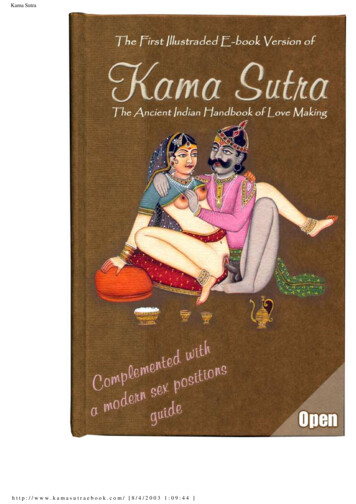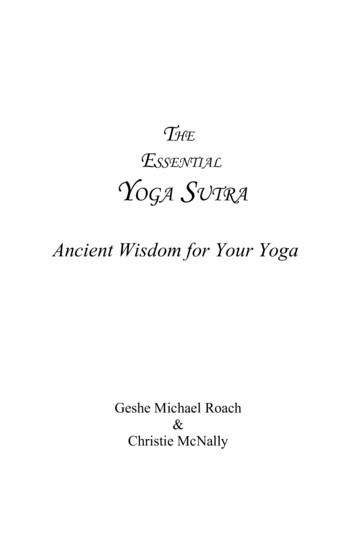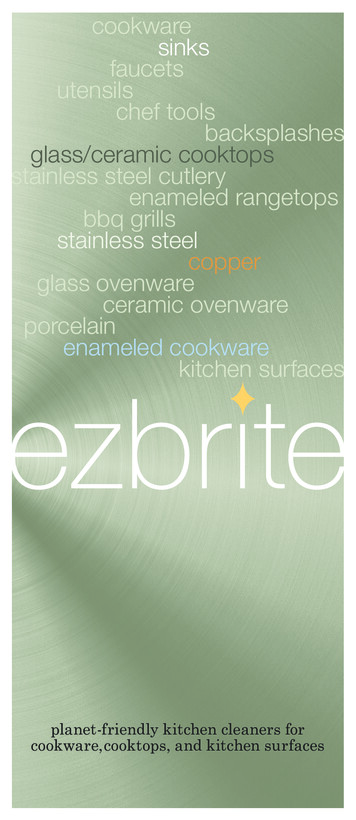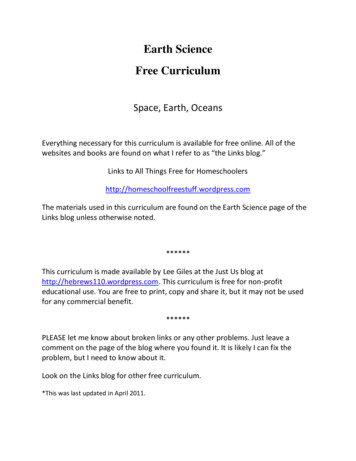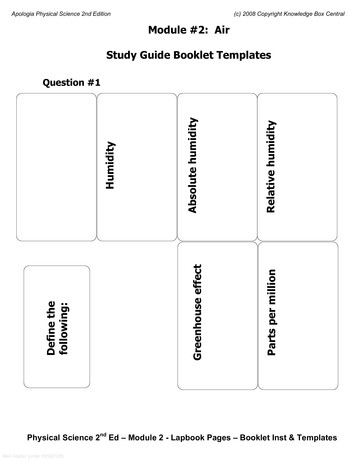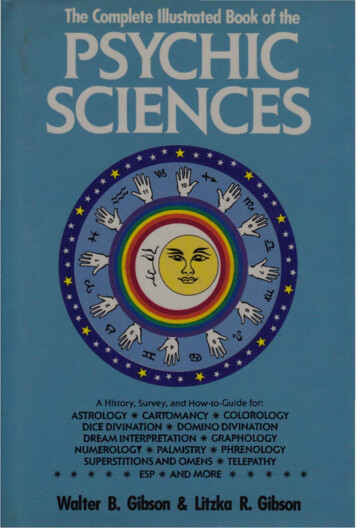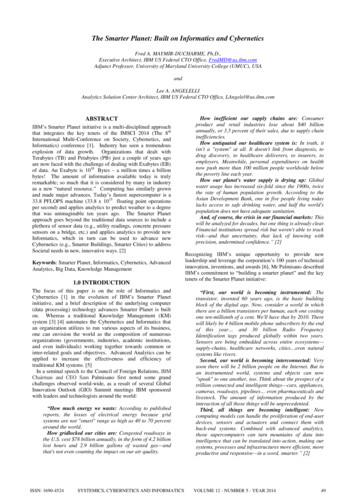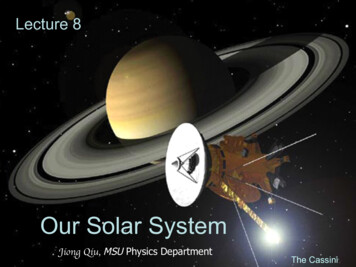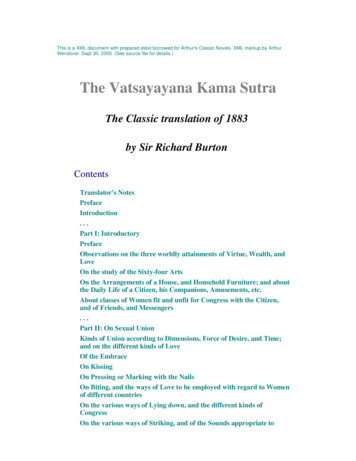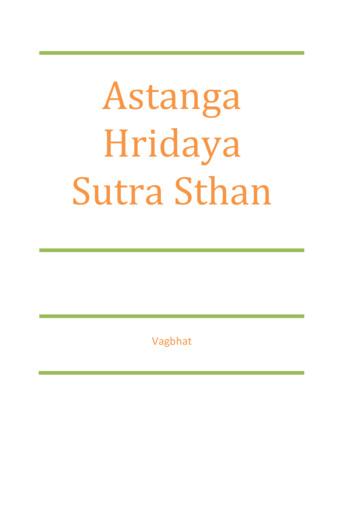
Transcription
AstangaHridayaSutra SthanVagbhat
Astanga Hridaya SutrasthanChapter 1: Ayushkameeya आयु कामीयं Adhyaya“Desire for long life”1. Salutationsरागा द रोगान ् सततानुष तान ् शेषकाय सतृ ानशेषान ्औ सु यमोहार तदा जघानयो अपूववै याय नमो अ तु त मैSalutation to The Unique and Rare Physician, who has destroyed, without any residue all thediseases like Raga (lust, anger, greed, arrogance, jealousy, selfishness, ego), which are constantlyassociated with the body, which is spread all over the body, giving rise to disease, delusion andrestlessness.This salutation is done to Lord Dhanwantari.2. Purpose of life: Essential quality to learn Ayurvedaआयु: कामायमानेन धमाथ सुखसाधनम ् । आयुवदोपदे शेषु वधेय: परमादर: ॥āyu: kāmāyamānena dharmārtha sukhasādhanam āyurvedopadeśeṣu vidheya: paramādara: To achieve the purpose of life, that is1. Dharma – following the path of righteousness2. Artha – earning money in a legal way3. Kama – fulfilling our desire4. Moksha – achieving Salvation,To achieve this purpose of life, one should concentrate on having a long life. To learn the scienceof Ayurveda, which explains how to achieve this purpose, ‘obedience’ (Vidheya) is the mostimportant quality.3. Origin of Ayurvedaमामृ वा आयुषो वे दंजाप तमिज हे सो अि वनौ तौ सह ा ं सो अ पु ा दका मुनी तेअि नवे शा दकां ते टु पथृ क् ता ण ते नरेLord Brahma, remembering Ayurveda, taught it to Prajapathi, he in turn taught it to AshwiniKumaras (twins), they taught it to Sahasraksa (Lord Indra), he taught it to Atri’s son (AtreyaPunarvasu) and other sages, they taught it to Agnivesa and others and they (Agnivesha and otherdisciples ) composed treatises, each one separately.Page No. 2Astanga Hridaya Sutrasthan
Astanga Hridaya Sutrasthan4 – 4.5. Funda of Ashtanga Hrudayam:ते यो अ त व क य यःायः सारतरो चयःयते अ टा ग दयं ना तसं ेप व तरम ्From those Ayurvedic text books, which are too elaborate and hence very difficult to study, onlythe essence is collected and presented in Ashtanga Hridaya, which is neither too short nor tooelaborate.4.5-5.5 – Branches of Ayurvedaकायबाल हो वा ग श यदं ा जरावषृ ान ् अ टाव गा न त याहु: च क सा येषु सं ता kāyabālagrahordhvāṅga śalyadaṃṣṭrā jarāvṛṣān aṣṭāvaṅgāni tasyāhu: cikitsā yeṣu saṃśritā 1.2.3.4.5.6.7.8.Kaya Chikitsa – General medicineBala Chikitsa – PaediatricsGraha Chikitsa – PsychiatryUrdhvanga Chikitsa – Diseases and treatment of Ear, Nose, Throat, Eyes and Head(neck and above region)Shalya Chikitsa – SurgeryDamshrta Chikitsa – ToxicologyJara Chikitsa – GeriatricsVrushya Chikitsa – Aphrodisiac therapyThese are the eight branches of Ayurveda.5.5 – 6.5 Tridoshaवायु: प तं कफ चे त यो दोषा: समासत: ॥ वकृताऽ वकृता दे हं नि त ते व तयि त च ।vāyu: pittaṃ kaphaśceti trayo doṣā: samāsata: vikṛtā’vikṛtā dehaṃ ghnanti te varttayanti ca Vayu – Vata, Pitta and kapha are the three Doshas of the body. Perfect balance of three Doshasleads to health, imbalance in Tridosha leads to diseases.6.5-7.5 How Thridosha are spread in body and in a day?ते या पनोऽ पना योरधोम यो व सं या: ॥वयोऽहोरा भु तानां तेऽ तम या दगा: मात ् ।te vyāpino’pi hṛnnābhyoradhomadhyordhva saṃśrayā: vayo’horātribhuktānāṃ te’ntamadhyādigā: kramāt The Tridosha are present all over the body, but their presence is especially seen in particularparts. If you divide the body into three parts, the top part upto chest is dominated by KaphaDosha, between chest and umbilicus is dominated by Pitta, below umbilicus part is dominated byVata.Page No. 3Astanga Hridaya Sutrasthan
Astanga Hridaya SutrasthanSimilarly, in a person’s life, day and in night (separately), the first part is dominated by Kapha,second part is dominated by Pitta and third part is dominated by Vata. While eating and duringdigestion, the first, second and third part are dominated by Kapha, Pitta and Vata respectively.7.5 Types of digestive firesतैभवे वषम: ती णो म द चाि न: समै: सम: ॥tairbhavedviṣama: tīkṣṇo mandaścāgni: samai: sama: There are four types of Digestive fires (Agni)1.2.3.4.Vishama Agni – Influenced by Vata. A person with Vishama Agni will sometimeshave high appetite, and sometimes, low appetite.Teekshna Agni - Influenced by Pitta. A person with Teeksna Agni will have highdigestion power and appetite.Manda Agni - Influenced by Kapha. A person with Manda Agni will have lowdigestion power and appetite.Sama Agni - Influenced by perfect balance of Tridosha – Where person will haveproper appetite and digestion power. Digestion occurs at appropriate time.8.5 Types of digestive tracts / nature of bowelsको ठ: ू रो मदु यो म य: या तै: समैर प ।ृ मkoṣṭha: krūro mṛdurmadhyo madhya: syāttai: samairapi There are three types of digestive tracts (Koshta):1. Kroora Koshta – wherein the person will take long time for digestion. The bowelevacuation will be irregular. It is influenced by Vata.2. Mrudu Koshta – Sensitive stomach, has a very short digestion period. Evenadministration of milk will cause bowel evacuation.3. Madhya Koshta – Proper digestive tract, bowel evacuation at appropriate times. It isinfluenced by Tridosha balance.9-10 Types of Prakruti – Body Typesशु ातव थै: ज मादौ वषेणवै वषकृमे: ॥ तै च त :कृतयो ह नम यो तमा: पथृ क् ।समधात:ु सम तासु े ठा न या वदोषजा ॥śukrārtavasthai: janmādau viṣeṇaiva viṣakṛme: taiśca tisra: prakṛtayo hīnamadhyottamā: pṛthak samadhātu: samastāsu śreṣṭhā nindyā dvidoṣajā Like the poison is natural and inherent to poisonous insects, similarly, the Prakruti (body type) isinherent to humans. The body type is decided during conception, based on qualities of sperm andovum.Vata prakruti – Vata body type is considered as low qualityPitta Prakruti – Pitta body type is considered as moderate qualityKapha Prakruti – Kapha body type is considered good quality.Page No. 4Astanga Hridaya Sutrasthan
Astanga Hridaya SutrasthanTridosha body type – influenced equally by Vata, Pitta and Kapha is considered thebest quality.Dual body types, Like Vata-Pitta, Pitta-Kapha, Vata-Kapha body types areconsidered as not good.10.5 Qualities of Vataतो लघ:ु शीत: खर: सू म चलोऽ नल: ॥tatra rūkṣo laghu: śīta: khara: sūkṣmaścalo’nila: Rooksha – dryness, Laghu – Lightness, Sheeta – coldness, Khara – roughness, Sookshma –minuteness, Chala – movement These are the qualities of Vata.11. Qualities of Pittaप तं स ने ह ती णो णं लघु व ं सरं वम ् ।pittaṃ sasneha tīkṣṇoṣṇaṃ laghu visraṃ saraṃ dravam Sasneha – slightly oily, unctuous, Teekshna – piercing, entering into deep tissues, Ushna –hotness, Laghu – lightness, Visram – bad smell, sara – having fluidity, movement, drava –liquidity are the qualities of Pitta.12. Qualities of Kaphaि न ध: शीतो गु म द: ल णो म ृ न: ि थर: कफ: ॥snigdha: śīto gururmanda: ślakṣṇo mṛtsna: sthira: kapha: Snigdhna – oily, unctuous, Sheeta – cold, Guru – heavy, Manda – mild, viscous, shlakshna –smooth, clear, Mrutsna – slimy, jely, sthira – stability, immobility are the qualities of Kapha.संसगः सि नपात च त वयकोपतःThe increase, decrease of individual Doshas, or imbalance of couple of these Doshas is called asSamsarga. And imbalance of all the three Doshas together is called as Sannipata.13. Body tissues and waste productsरस असकृ ् मांस मेदो अि थ म ज शु ा ण धातव: ।स त द ू या: मला: मू शकृत ् वेदादयोऽ प च ॥rasa asṛk māṃsa medo asthi majja śukrāṇi dhātava: sapta dūṣyā: malā: mūtra śakṛt svedādayo’pi ca Body tissues and waste products are called as Dushyas. Means, there are influenced, and affectedby Doshas. Body tissues are -Page No. 5Astanga Hridaya Sutrasthan
Astanga Hridaya Sutrasthan1.2.3.4.5.6.7.Rasa - the first product of digestion, Soon after digestion of food, the digested foodturns into Rasa. It is grossly compared to lymph or plasma. But it is not a completecomparison.Rakta – Also called as Asruk. – BloodMamsa – MuscleMeda - Fat tissueAsthi - Bones and cartilagesMajja - Bone marrowShukra – Semen / Ovum or entire male and female genital tract and its secretions aregrossly covered under this heading.Mala – waste productsShakrut / Pureesha – (faeces), Sweda (sweat) and Mootra (urine) are the three waste products ofthe body.13.5 Nature of increase and decreaseव ृ : समानै: सवषां वपर तै: वपयय: ।vṛddhi: samānai: sarveṣāṃ viparītai: viparyaya: Equal qualities lead to increase, and opposing qualities lead to decrease. For example, dryness isthe quality of Vata. If a Vata body type person exposes himself to dry cold weather, his drynessand in turn Vata will increase, leading to dry skin. In the same way, oiliness is opposite quality ofdryness. If he applies oil to the skin, then the dryness and related Vata is decreased.13.5 Six tastesरसाःवा व ललवण त � ते च यथापूव बलावहाःSvadu – Madhura – sweet, Amla – Sour, Lavana – Salt, Tikta – Bitter, Ushna – Katu – Pungent,Kashaya – Astringent are the six types of Rasa.They are successively lower in energy. That means, Sweet taste imparts maximum energy tobody and the astringent, the least.14. Effect of tastes on Tridoshaत ा या मा तंनि तय: त तादय: कफम ् ।कषाय त त मधरु ा: प तम ये त ु कुवते ॥tatrādyā mārutaṃ ghnanti traya: tiktādaya: kapham kaṣāya tikta madhurā: pittamanye tu kurvate In the list of tastes, the first three, i.e. Sweet, sour and salt mitigates Vata and increases Kapha.The last three, i.e. bitter, pungent and astringent tastes mitigates Kapha and increases VataAstringent, bitter and sweet taste mitigates Pitta. Sour, salt and pungent tastes increase Pitta.Page No. 6Astanga Hridaya Sutrasthan
Astanga Hridaya SutrasthanTypes of food substances:Shamana – Food that brings down the increased Dosha to normalcyKopana – Food that increases the lowered Dosha to normalcySwasthahita - Food that maintains the normalcy of Tridosha and health.Types of Potency (Veerya)Ushna veerya (Hot potency) -Some food items are hot in nature. For example pepperSheeta veerya (cold potency) - Some food items are cold in nature. For example milk.These are the two types of potencies. Generally, substances that have Astringent, bitter and sweettastes are coolant in nature and Sour, salt and pungent tastes are hot in nature.Three types of VipakaVipaka refers to conversion of taste after initial phase of digestion. Madhura Vipaka (sweet) – Generally, Sweet, and salt tastes undergo this Vipaka. Amla Vipaka (Sour) – Sour taste undergoes this Vipaka Katu Vipaka – rest of the tastes – Bitter, astringent and pungent tastes undergo thisVipaka.18. – Twenty types of qualitiesगु म द हम ि न ध ल ण सामदु ा: ससू म वशदा: वंश त: स वपयया: ॥ृ ु ि थरा: । गणguru manda hima snigdha ślakṣṇa sāndra mṛdu sthirā: guṇā: sasūkṣma viśadā: viṃśati: saviparyayā: Guru(heavy) X laghu (light in weight)Manda(slow) X tiksna(quick,fast)Hima (cold) X ushna (hot)Snighda (unctuous) X ruksa (dry)Slaksna (smooth) X khara (rough)Sandra (solid) X drava (liquid)Mrdu (soft) X kathina (hard)Sthira (stable) X cala (moving, unstable)Suksma (stable, small) X sthula (big,gross)Vishada (non slimy) X picchila (slimy)19. Cause for health and disease:कालाथकमणां योगो ह न म या तमा क: । स य योग च व ेयो रोगारो यैक कारणम ् ॥kālārthakarmaṇāṃ yogo hīnamithyātimātraka: samyagyogaśca vijñeyo rogārogyaika kāraṇam Less, more or wrong unison of time, senses and functions is the reason for disease and the rightunison of these three factors is the reason for health. (Explained detail in further chapters).Page No. 7Astanga Hridaya Sutrasthan
Astanga Hridaya Sutrasthan20. Definition of health and diseaseरोग तु दोषवैष यं दोष सा यं अरोगता । rogastu doṣavaiṣamyaṃ doṣa sāmyaṃ arogatā Imbalance in Tridosha is disease. Perfect balance is health.21. Types of disease:नजाग त ु वभागेन तरोगावधामतृ ाःNija roga – Disease caused due to imbalance in internal factors. For example, eatingexcessive hot substances, leading to gastritis.Agantu Roga - Disease caused due to external factors. Such as injuries. Both thesetypes of disease can occur to body and mind.21. Types of mental Doshas –तेषां कायमनोमेदाद ध ठानाम प वधारज तम च मनसो वौ च दोषावुदा तौRajas – quality of mind, that drives us to take actions,Tamas – that leads to inaction and lethargy22. How to test patient?दशन पशन नैः पर े त च रो गणम ्Darshana – by means of inspection, observation.Sparshana - by means of touchingPrashna – by means of asking23. Examination of disease:रोगं नदान ा पू ल णोपशयाि त भःDisease should be examined by itsNidana -causes, aetiology,Pragrupa – Purvarupa – prodromal symptoms, premonitory symptomsLakshana – Specific signs and symptoms, clinical featuresUpashayaa – diagnostic testsApti – Samprapti – Pathogenesis.Types of Habitat (Desha)भू मदे ह भेदेन दे शमाहु रहवधाजा गलं वातभू य ठमनूपं तु कफो बण साधारणं सममलंधाभूदेशमा दशेत ्In this science, is said to be of two kinds - Bhumi desha – region of land and Dehadesha –the body. Bhumi desa - land region is of three kinds of viz,Jangala -which is predominant of vata – arid or desert-like land with no mountains or hills,has less vegetation, poor water resourses and is more breezy.Anupa - which is predominant of kapha - marshy land with more of water, more vegetation ,very less of sunlight and heat.Sadharana which has all Tridosha in balance - moderate type with few mountains , hills,moderate water, vegetation and sunlight.Page No. 8Astanga Hridaya Sutrasthan
Astanga Hridaya SutrasthanKinds of time:णा द या यव था च कालो भेषजयोगकृत ्Two kinds are considered- one is normal time, another – stages of diseases.25-26 Types of medicines:शोधनं शमनं चे त समासात ् औषधंवधा ॥ शर रजानां दोषाणांमेण परमौषधम ् ।बि त: वरे को वमनं तथा तैल घ तृ ं मधु: ॥śodhanaṃ śamanaṃ ceti samāsāt auṣadhaṃ dvidhā śarīrajānāṃ doṣāṇāṃ krameṇaparamauṣadham basti: vireko vamanaṃ tathā taila ghṛtaṃ madhu: There are two types of medicines.1. Shamana - Palliative treatment – which brings the Dosha to normalcy, useful in initial stagesof diseases2. Shodhana – Purification treatment – which expels imbalanced Dosha out of body. – Useful inaggravated stages of diseases.Examples:For Vata – Basti (suppositories) is the Shodhana treatment, and oil is Shamana treatment.For pitta – Virechana (Purgation) is Shodhana and Ghee is Shamana.For Kapha – Vamana (emesis) is Shodhana and Honey is Shamana.26. Treatment for mental imbalance:धीधैया मा द व ानं मनोदोषौषधं परम ्Dhee – improving intelligenceDhairya – improving courageAtmavijnana – Self realization are the means to treat mental imbalance.27-29. 16 factors of treatment. Chikitsa Chatushpadaभषग ्या युप थाता रोगी पादचतु टयम ् च क सत यन द टं ,येकं त चतुगणम्ु- Bhishag (Doctor), Dravya (medicine), Upastha (Nurse) and Rogi (patient) are the fourfactors in treatment. Each of these four have further four qualities.Page No. 9Astanga Hridaya Sutrasthan
Astanga Hridaya SutrasthanQualities of doctor:द ः तीथा तशााथटकमा शु च भषकDaksha – Alert, disciplinedShastra – Having detailed knowledge about diseases and treatment.Drushtakarma – Having practical experienceShuchi – CleanlinessQualities of medicine:बहुक पं बहु गणु ं संप नं यो यमौषधम ्Bahukalpa – Ability to formulate in different dosage forms, like decoction, powder,herbal oil etcBahuguna – Having enormous qualitiesSampanna – Endowed with virtuesYogya - suitable and appropriate for specific diseases.Qualities of nurse:अनरु तः शु चद ो बु मान ् प रचारकःAnurakta – Compassion towards patientsShuchi – CleanlinessDaksha – Alert, activeBuddhiman – IntelligenceQualities of patientआ यो रोगी भष व योापकः स वान पAdya - RichBhishagvashya – 100 % obedience towards doctorJnapaka – Good memorySatvavaan – Having good strength to tolerate disease and treatment.Types of diseases:सा यो असा य इ त या ध वधा तौ तु पुन वधासुसा यः कृसा य च, या यो य चानुप मःTwo main types, which are further divided into two types.Sadhya - Which can be cured. It is of two types – Easy to cure (Sukha Sadhya), Difficult to cure(Krichra Sadhya)Page No. 10Astanga Hridaya Sutrasthan
Astanga Hridaya SutrasthanAsadhya - Which can not be cured. It is of two types – Yapya (medicine is required for as longas patient is alive), Anupakrama (nothing can be done. )Qualities of diseases which can be cured easily:सव षध मे दे हे यूनः पुंसो िजता मनःअममगो अ पहे वप पोअनुप वःअतु यद ू यदे शत ु कृ तः पादस प द हे वनुगनु े वेकदोषमाग नवः सुखःSarvaushadha kshame dehe – The body of patient is able to tolerate all types of medicinesYunaha – Young patientJitatmanaha – Patient having good control over sense organs, who follows abstinenceAmarmaga – If the disease is not affected sensitive areas like brain, heart, kidneyAlpahetu – If the cause for disease is mildAlparoopa – Mild symptomsAnupadrava – no complicationsAtulya dushya desha rutu prakruti – If the Dosha involved, Dhatu (body tissue) involved,Desha (place), Rutu (season) and Prakruti (body type) are not influenced by one particular Dosha,Pada sampadi - If all the sixteen qualities of Doctor, patient etc explained above are present,Graha anuguna - If astrology is in favour of the patientEka Doshaja - Disease due to only one DoshaEka Marga - If only one body channel is affectedNava - Disease of recent origin / onset.32. qualities of difficult-to-treat diseasesशा दसाधनः कृअनुप म एवयािः स करे च ततो गदःशे ष वादायुषो या यः प या यासा वपययेथतो अ य त वपययेऔ सु यमोहार तकृद ु ट र टो अ नाशनःDisease which require the use of sharp instruments etc. in treatment . and also those which havemixture of factors enumerated in previous verses are krcchra sadhya (curable with difficulty ).Diseases which have features entirely opposite of curable diseases, which have stayed for longperiod of time, involving all the important tissues and vital organs, which have produced anxiety(fear of death), delusion and restlessness; which are presenting fatal signs and which causes lossof sense organs are impossible to cure. (Anupakrama ), which require no therapy, fit to berejected, sure to cause death.33. Patient worth rejection:येजेदात भष भूपै व टं तेषांकृत नं वै यमा ननम ्वषंवष ह नोपकरणं य म वधेयं गतायुष च डं शोकातुरं भी ंThe physician should reject the patient, who is hated by physician and the king and who hatesthem; who hates himself (dejected in life), who is not having the equipments and other facilitiesrequired for treatment, who is busy with other activities, not having the required attention, leisureetc. towards the treatment, who is disobedient (to the physician), whose life is coming to an end,who is of evil mind (violent, destructive), who is afflicted with great grief, who is full of fear,who is ungrateful and who thinks himself to be a physician (in respect of deciding drug,therapies, food, activities etc) .Page No. 11Astanga Hridaya Sutrasthan
Astanga Hridaya SutrasthanList of other chapters.त ा या य परम ् चातो व यते अ यायसहःI. SUTRASTHANAआयु काम दन वह हारोगानु पादन याःअ न ाना नसं र ामा ाकया युप माःशुधः श य व धः शयरसा याःदोषा द ानत वेदति चया द नेह वेदरे का थापननावन धूम ग डूषाराि नक मकौसूतान ममे अ यायािसे कतिृ तयकशकि शरा वशं त्1. Ayuskamiya adhyaya (desire for long life).2. Dinacarya adhyaya (daily regimen).3. Rtucarya adhyaya (seasonal regimen).4. Roganutpadaniya adhyaya (prevention of diseases).5. Dravadravya vijnaniya adhyaya (knowledge of liquid materials).6. Annasvarupa vijnaniya adhyaya (nature of food materials).7. Annaraksadhyaya (Protection of foods).8. Matrasitiyadhyaya (Proper quantity of food).9. Dravyadi vijnaniya adhyaya (Knowledge of substances etc.).10. Rasabhediya adhyaya (classification of tastes).11. Dosadi vijnaniya adhyaya (Knowledge of dosas etc.).12. Dosabhediya adhyaya (classification of dosas).13. Dosopakramaniya adhyaya (treatment of the dosas).14. Dvividhopakramaniya adhyaya (two kinds of treatments).15. Sodhanadigana sangraha adhyaya (groups of drugs for purificatory therapies etc.).16. Sneha vidhi adhyaya (oleation therapy).17. Svedavidhi adhyaya (sudation therapy).18. Vamana virecana vidhi adhyaya (emesis and purgation therapies).19. Basti vidhi adhyaya (enema therapy).20. Nasya vidhi adhyaya (nasal medication).21. Dhumapana vidhi adhyaya (inhalation of smoke therapy).22. Gandusadi vidhi adhyaya (mouth gargles and other therapies).23. Ascyotana-anjana vidhi adhyaya (eye drops, collyrium therapies).24. Tarpana-putapaka vidhi adhyaya (satiating the eye and other therapies).25. Yantra vidhi adhyaya (use of blunt instruments).26. Sastra vidhi adhyaya (use of sharp instruments).27. Siravyadha vidhi adhyaya (venesection).28. Salyaharana vidhi adhyaya (removal of foreign bodies).29. Sastrakarma vidhi adhyaya (surgical operation).30. Ksaragnikarma vidhi adhyaya (alkaline and thermal cautery).Page No. 12Astanga Hridaya Sutrasthan
Astanga Hridaya SutrasthanII. SARIRA STHANA (SECTION ON ANATOMY, PHYSIOLOGY ETC).शार रमु यतेगभाव ाि ततयापद गममा वभा गकि वकृ तदतजंष ठम ्ू1. Garbhavakranti sarira (embryology).2. Garbhavyapad sarira (disorders of pregnancy).3. Anga vibhaga sarira (different parts of the body).4. Marma vibhaga sarira (classification of vital spots).5. Vikrti vijnaniya sarira (knowledge of bad prognosis).6. Dutadi vijnaniya sarira (knowledge of messenger etc.).III. NIDANA STHANA (DIAGNOSIS OF DISEASES):नदानं सावरो गकवरास ृचपा डुकु ठा नलातानां वातावासय मा दमदा यश तसा रणा मू ाघात मेहाणां वय च षोडशाया युदर य1. Sarvroga nidanam (diagnosis of diseases in general).2. Jvara nidanam (diagnosis of fever).3. Raktapitta, Kasa nidanam (disease and cough).4. Svasa-Hidhma nidanam (diagnosis of bleeding disease and cough).5. Rajayaksmadi nidanam (diagnosis of pulmonary tuberculosis etc.).6. Madatyaya nidanam (diagnosis of alcoholic intoxication).7. Arsas nidanam (diagnosis of haemorrhoids).8. Atisara-Grahani nidanam (diagnosis of diarrhoea and duodenal disorders).9. Mutraghata nidanam (diagnosis of retention of urine).10. Prameha nidanam (diagnosis of diabetes).11. Vidradhi-Vrddhi-Gulma nidanam (diagnosis of abscess, enlargement of the scrotum andabdominal tumour).12. Udara nidanam (diagnosis of enlargement of the abdomen).13. Panduroga-sopha-visarpa nidanam (diagnosis of anaemia, dropsy and herpes).14. Kustha-svitra-krimi nidanam (diagnosis of leprosy, leucoderma and parasites).15. Vata vyadhi nidanam (diagnosis of diseases of the nervous system).16. Vatasonita nidanam (diagnosis of gout).IV. CIKITSITA STHANA (THERAPEUTICS):च कि सतंवरे र ते वासे कासे च य म णवामौ मदा यये अशःसु, व शवौ, वौ चमू ते व धौ गु मजठरपा डुशोफ वस पषुकु ठि व ा नल या धवाता ेषु च कि सतवा वंश त रमेअ यायाः1. Jvara cikitsita (treatment of fevers).2. Raktapitta cikitsita (treatment of bleeding disease).3. Kasa cikitsita (treatment of cough).4. Svasa-Hidhma cikitsita (treatment of dyspnoea and hiccup).5. Rajayaksmadi cikitsita (treatment of pul. tuberculosis, etc.).6. Chardi-Hrdroga-Trsna cikitsita (treatment of vomiting, heart disease and thirst).7. Madatyaya cikitsita (treatment of alcoholic intoxication).Page No. 13Astanga Hridaya Sutrasthan
Astanga Hridaya Sutrasthan8. Arsas cikitsita (treatment of haemorrhoids).9. Atisara cikitsita (treatment of diarrhoea).10. Grahani dosa cikitsita (treatment of duodenal disorder).11. Mutraghata cikitsita (treatment of retention of urine).12. Prameha cikitsita (treatment of diabetes).13. Vidradhi-vrddhi cikitsita (treatment of abscess, enlargement of the scrotum).14. Gulma cikitsita (treatment of abdominal tumour).15. Udara cikitsita (treatment of enlargement of the abdomen).16. Pandu roga cikitsita (treatment of anaemia).17. Svayathu (sopha) cikitsita (treatment of dropsy).18. Visarpa cikitsita (treatment of herpes).19. Kustha cikitsita (treatment of leprosy).20. Svitra-krimi cikitsita (treatment of leucoderma and parasites).21. Vata vyadhi cikitsita (treatment of diseases of the nervous system).22. Vatasonita cikitsita (treatment of gout).V. KALPASIDDHI STHANA (PURIFICATORY RECIPES, PHARMACEUTICS):क पसरतः पर क पो वमो वरे क य ति स बि तक पना सबयापदां ष ठोयक पः1. Vamana kalpa (emetic recipes).2. Virecana kalpa (purgative recipes).3. Vamana virecana vyapat siddhi (management of complications of emesis and purgationtherapies).4. Basti kalpa (enema recipes).5. Basti vyapat siddhi (management of complications of enema therapy).6. Dravya-kalpa (pharmaceutics).VI. UTTARASTHANA:अत उ तर बालोपचारे तसं धषुतमो ल गनाशे षुु रोगेषु ग ु यरोगे पथृबीजपोषणःयाधौ तयो, वौहे , वौ च भूतगेउ मादे अथम ृ त ंशो, वौवौ व मसुवौ च सवगे कणनासामुख शरो णे , भ गे भग दरेयादौवयि वषे भजु गे क टे षु मु के षु रसायनेच वा रंशो अनप यानाम यायो1. Balopacaraniya adhyaya (care of the new born baby).2. Balamaya pratisedha (treatment of diseases of children).3. Balagraha pratisedha (treatment of evil spirits).4. Bhuta vijnaniya (knowledge of demons).5. Bhuta pratisedha (treatment of demons).6. Unmada pratisedha (treatment of insanity).7. Apasmara pratisedha (treatment of epilepsy).8. Vartma roga vijnaniya (knowledge of diseases of eyelids).9. Vartma roga pratsedha (treatment of diseases of eyelids).10. Sandhisitasita roga vijnaniya (knowledge of diseases of fornices, sclera and cornea).11. Sandhisitasita roga pratisedha (treatment of diseases of fornices, sclera and cornea).Page No. 14Astanga Hridaya Sutrasthan
Astanga Hridaya Sutrasthan12. Drsti roga vijnaniya (knowledge of diseases of vision).13. Timira pratisedha (treatment of blindness).14. Linganasa pratisedha (treatment of blindness).15. Sarvaksi roga vijnaniya (knowledge of diseases of the whole eye).16. Sarvaksi roga pratisedha (treatment of diseases of the whole eye).17. Karna roga vijnaniya (knowledge of diseases of the ear).18. Karna roga pratisedha (treatment of diseases of the ear).19. Nasa roga vijnaniya (knowledge of the diseases of the nose).20. Nasa roga pratisedha (treatment of diseases of the nose).21. Mukha roga vijnaniya (knowledge of the diseases of the mouth).22. Mukha roga pratisedha (treatment of diseases of the mouth).23. Siro roga vijnaniya (knowledge of the diseases of head).24. Siro roga pratisedha (treatment of diseases of the head).25. Vrana pratisedha (treatment of ulcers).26. Sadyo vrana pratisedha (treatment of traumatic wounds).27. Bhanga pratisedha (treatment of fractures).28. Bhagandara pratisedha (treatment of rectal fistula)29. Granthi-arbuda-slipada-apaci-nadi vijnaniya (knowledge of tumours, cancers, filariasis,scrofula and sinus ulcer).30. Granthyadi pratisedha (treatment of tumours etc.).31. Ksudra roga vijnaniya (knowledge of minor diseases).32. Ksudra roga pratisedha (treatment of minor diseases).33. Guhya roga vijnaniya (knowledge of diseases of genital organs).34. Guhya roga pratisedha (treatment of diseases of genital organs).35. Visa pratisedha (treatment of poisoning).36. Sarpa visa pratisedha (treatment of snake bite poison).37. Kitalutadi visa pratisedha (treatment of poison of insects, spiders etc.).38. Musika-alarka visa pratisedha (treatment of poison of mouse, rabid, dog etc.).39. Rasayana vidhi (rejuvination therapy).40. Vajikarana vidhi (virilification therapy).इ य यायशतं वंशं ष भःथानै द रतम ्End of first chapter of Sutrasthana of Ashtanga Hridayam.Page No. 15Astanga Hridaya Sutrasthan
Astanga Hridaya SutrasthanChapter 2: Dinacharya दनचया Daily RoutineThis is the second Chapter of Ahstanga Hrudaya Sutrasthana – Called as Dinacharya – Ayurvedicdaily routine. Dina means daily, Charya means – regimen/routine. This chapter covers mental,speech and physical aspects of well being, that you should follow every day.1. PRATARUTHANA / GETTING UP IN THE MORNINGा मे मुहूत उि त ठेव थो र ाथमायुषःHealthy person should get up from bed at Brahmi Muhurtha. That is, before dawn, or around 45minutes before Sun rise, around 5 – 6 am. Last three hours of the night – from 3 am to 6 am – isknown as brahma muhurta.2-3 – DANTADHAVANA / CLEANING OF TEETHशर र च तां नव य कृतशौच व ध ततःअक य ोधख दरकर जककुभा दजम ्ातभुवा च म ृ व ं कषायकटु त तकम ्कनी य सम थौ यंभ येगुणंवादशा गलु म्तपवनं द तमांसा यबाधयन ्Keeping in view, the condition of his body, the individual should pass urine and faeces, cleanteeth with any of the twigs of following herbs –Arka (Calotropis procera),Vata (Ficus benghalensis),Khadira (Acacia catechu),Karanja (Pongamia pinnata),Kakubha (Terminalia arjuna).To use the twig as tooth brush, the thickness of the twig should be approximately equal to the tipof one’s little finger. It should be 12 Angula length. The tip of the twig should be chewed a littleto make it as brush. The twig should be of astringent, pungent and bitter in taste.4. Danta Dhawana Nishedha – Who should not brush teeth ना यादजीणवमथु वासकास वरा दतीत ृ णा यपाकने शरः कणमयी च तत ्The following individuals should not do teeth brushing. – people suffering from indigestion,vomiting, dyspnoea, cough, fever, facial paralysis, excessive thirst, ulceration of mouth, heartdisease, diseases of eyes, head and ears.Page No. 16Astanga Hridaya Sutrasthan
Astanga Hridaya Sutrasthan5. Anjana – Collyriumसौवीरम जनं न यं हतम णो ततो भजेत ् । च ु तेजोमयं त य वशेषात ् ले मतो भयम ् ॥योजये स तरा ेऽ मात ् ावणाथ रसा जनम ् ।sauvīramañjanaṃ nityaṃ hitamakṣṇostato bhajet cakṣustejomayaṃ tasya viśeṣāt śleṣmatobhayam yojayetsaptarātre’smāt srāvaṇārthaṃ rasāñjanam It is good to apply a special type of collyrium called Sauveera Anjana to the eyes. It should beapplied daily. Rasanjana (aqueous extract of Berberis aristata), should be applied once in a week,to drain out Kapha (secretions) from the eyes.6 - Navana and Gandushaततो नावनग डूषधूम ता बूलभा भवे त ्- After collyrium application, healthy person should do Navana (Nasya – Nasal instillation ofdrops.). For this purpose, milk, herbal decoctions, herbal oils are usually used.After that, Gandusha – gargling with warm water, milk, or herbal decoction or herbal oil shouldbe done. Then Dhuma – inhalation of smoke from herbs and spices should be done, and thenbetel leaves should be chewed.7 – Contra indication for Tambula – betel leaf chewing –ता बलू ंत पताो कु पतच ुषाम ्वषमू छामदातानामप यं शो षणाम पThose suffering from wounds, bleeding diseases, dryness, redness of eye, poisoning,repeated unconsciousness, intoxication and from tuberculosis should avoid betel leaf chewing.8-9. Abhyanga – oil massageअ य गं आचरे त ् न यं , स जरामवातहा ।ि टसाद पुि ट आयु: सु व न सु वक् दा यकृत ्॥ शर: वणपादे षु तं वशेषेण शीलयेत ् । व य ऽ य ग: कफ थकृत संशुअजी ण भ: ॥abhyaṅgaṃ ācaret nityaṃ, sa jarā śramavātahā dṛṣṭi prasāda puṣṭi āyu: susvapna
From those Ayurvedic text books, which are too elaborate and hence very difficult to study, only the essence is collected and presented in Ashtanga Hridaya, which is neither to

